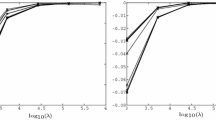Abstract
The Lagrangian dual of an integer program can be formulated as a min-max problem where the objective function is convex, piecewise affine and, hence, nonsmooth. It is usually tackled by means of subgradient algorithms, or multiplier adjustment techniques, or even more sophisticated nonsmooth optimization methods such as bundle-type algorithms.
Recently a new approach to solving unconstrained convex finite min-max problems has been proposed, which has the nice property of working almost independently of the exact evaluation of the objective function at every iterate-point.
In the paper we adapt the method, which is of the descent type, to the solution of the Lagrangian dual. Since the Lagrangian relaxation need not be solved exactly, the approach appears suitable whenever the Lagrangian dual must be solved many times (e.g., to improve the bound at each node of a branch-and-bound tree), and effective heuristic algorithms at low computational cost are available for solving the Lagrangian relaxation.
We present an application to the Generalized Assignment Problem (GAP) and discuss the results of our numerical experimentation on a set of standard test problems.
Similar content being viewed by others
References
Beasley, J.: OR-library, distributing test problems by electronic mail. J. Oper. Res. Soc. 41, 1069–1072 (1990)
Bertsekas, D., Tsitsiklis, J.N.: Neuro-Dynamic Programming. Athena Scientific, Belmont (1996)
Cattrysse, D.G., Van Wassenhove, L.N.: A survey of algorithms for the generalized assignment problem. Eur. J. Oper. Res. 60, 260–272 (1992)
Fisher, M.L.: The Lagrangean relaxation method for solving integer programming problems. Manag. Sci. 27, 1–18 (1981)
Fisher, M.L., Jaikumar, R., Van Wassenhove, L.N.: A multiplier adjustment method for the generalized assignment problem. Manag. Sci. 32, 1095–1103 (1986)
Gaudioso, M., Giallombardo, G., Miglionico, G.: An incremental method for solving convex finite min-max problems. Math. Oper. Res. 31, 173–187 (2006)
Geoffrion, A.M.: Lagrangean relaxation and its uses in integer programming. Math. Program. Study 2, 82–114 (1974)
Goldfarb, D., Idnani, A.: A numerically stable dual method for solving strictly convex quadratic program. Math. Program. 27, 1–33 (1983)
Grippo, L.: Convergent on-line algorithms for supervised learning in neural networks. IEEE Trans. Neural Netw. 11, 1284–1295 (2000)
Hiriart-Urruty, J., Lemaréchal, C.: Convex Analysis and Minimization Algorithms, vols. I, II. Springer, New York (1993)
Martello, S., Toth, P.: Knapsack Problems: Algorithms and Computer Implementations. Wiley, New York (1990)
Nauss, R.M.: Solving the generalized assignment problem: an optimizing and heuristic approach. INFORMS J. Comput. 15, 249–266 (2003)
Nedic, A., Bertsekas, D.P.: Incremental subgradient methods for nondifferentiable optimization. SIAM J. Optim. 12, 109–138 (2001)
Nemhauser, G., Wolsey, L.A.: Integer and Combinatorial Optimization. Wiley, New York (1988)
Savelsbergh, M.: A branch and price algorithm for the generalized assignment problem. Oper. Res. 45, 831–841 (1997)
Yagiura, M., Ibaraki, T., Glover, F.: An ejection chain approach for the generalized assignment problem. INFORMS J. Comput. 16, 133–151 (2004)
Yagiura, M., Ibaraki, T., Glover, F.: A path relinking approach with ejection chains for the generalized assignment problem. Eur. J. Oper. Res. 169, 548–569 (2006)
Author information
Authors and Affiliations
Corresponding author
Additional information
This research has been partially supported by the Italian “Ministero dell’Università e della Ricerca Scientifica,” under PRIN2005 research project “Numerical methods for global optimization and for some classes of nondifferentiable optimization” (2005017083_002).
Rights and permissions
About this article
Cite this article
Gaudioso, M., Giallombardo, G. & Miglionico, G. On solving the Lagrangian dual of integer programs via an incremental approach. Comput Optim Appl 44, 117–138 (2009). https://doi.org/10.1007/s10589-007-9149-2
Received:
Revised:
Published:
Issue Date:
DOI: https://doi.org/10.1007/s10589-007-9149-2




